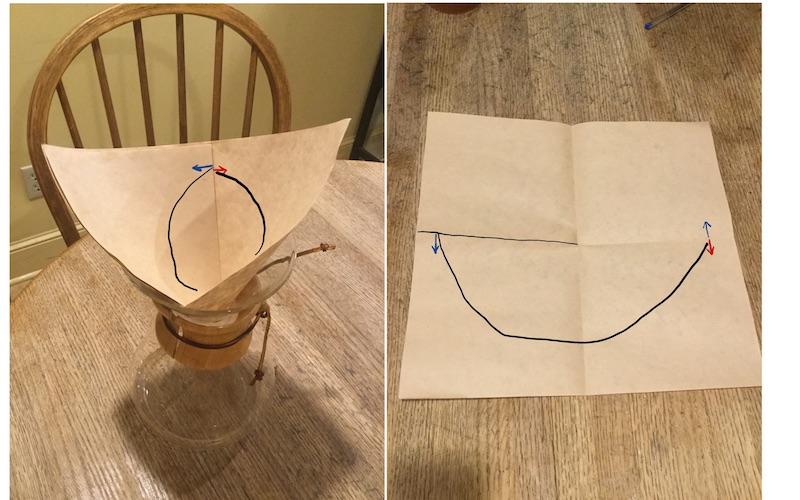Click here to return to the main course web page.
This homework set is out of 40 points.
It explores the concept of parallel transport and how parallel transport on one surface
relates to parallel transport on another.
-
(10 points)
Let \(U \subseteq \mathbb{R}^2\) be nonempty and open and let \(\sigma,\tau:U \to \mathbb{R}^3\) be two
regular surface patches which have the same first fundamental form (i.e. \(E\), \(F\), \(G\) are the same).
Show that if \(\mathbf{u}\) is a smooth vector field along a smooth curve \(\gamma\) in \(U\),
then
\(
\mathbf{v}(t) := D_{\gamma(t)} \sigma(\mathbf{u}(t))
\)
is a parallel vector field along
\(\sigma \circ \gamma\) if and only if
\(
\mathbf{w}(t) := D_{\gamma(t)} \tau (\mathbf{u}(t))
\)
is a parallel vector field along \(\tau \circ \gamma\).
Hint: This problem is not as bad as it looks.
It amounts to applying the right theorem, proposition, etc. from the text/lecture.
Remark: While this problem does not talk explicitly about parallel transport, but it does give information.
For instance if \(p\) and \(q\) are on \(\gamma\), \(\mathbf{u} \in T_p \mathbb{R}^2 = \mathbb{R}^2_p\) and
\(\mathbf{v}\) is in \(T_q \mathbb{R}^2 = \mathbb{R}^2_q\),
then
\[
D_q \sigma (\mathbf{v}) = \Pi_\alpha^{\sigma(p),\sigma(q)} (D_p \sigma (\mathbf{u})) \qquad \textrm{ if and only if } \qquad
D_q \tau (\mathbf{v}) = \Pi_\beta^{\tau(p),\tau(q)} (D_p \tau (\mathbf{u}))
\]
where \(\alpha = \sigma \circ \gamma\) and \(\beta = \tau \circ \gamma\).
-
 (10 points)
Given \(0 < a < 1\), let \(C\) be the surface parametrized by the local diffeomorphism
\[
\sigma(r,\theta) = (ar \cos(\theta/a),ar \sin (\theta/a), r \sqrt{1-a^2}).
\]
If \(\alpha\) is the curve defined by
\(\alpha(t) = (a r_0 \cos(t), a r_0 \sin(t), r_0 \sqrt{1-a^2})\) for \(0 \leq t \leq 2\pi\),
determine the angle between a vector \(\mathbf{v} \ne 0\) in \(T_{\alpha(0)} C\)
and the result of parallel transporting \(\mathbf{v}\) once around \(\alpha\).
(10 points)
Given \(0 < a < 1\), let \(C\) be the surface parametrized by the local diffeomorphism
\[
\sigma(r,\theta) = (ar \cos(\theta/a),ar \sin (\theta/a), r \sqrt{1-a^2}).
\]
If \(\alpha\) is the curve defined by
\(\alpha(t) = (a r_0 \cos(t), a r_0 \sin(t), r_0 \sqrt{1-a^2})\) for \(0 \leq t \leq 2\pi\),
determine the angle between a vector \(\mathbf{v} \ne 0\) in \(T_{\alpha(0)} C\)
and the result of parallel transporting \(\mathbf{v}\) once around \(\alpha\).
Hint:
Define \(\tau(r,\theta) = (r \cos(\theta),r \sin (\theta),0)\) and use
problem 1 to convert the parallel transport problem on \(C\) to a (trivial) parallel transport
problem in the \(xy\)-plane. (See the remark at the end of problem 1.)
The calculations you did in HW7, problems 3 and 4 may be helpful.
-
(10 points)
Suppose that \(S_1\) and \(S_2\) are two smooth surfaces in \(\mathbb{R}^3\),
\(\gamma\) is a smooth curve contained in their intersection
and \(T_p S_1 = T_p S_2\) for all points \(p\) on \(\gamma\).
Show that parallel transport along \(\gamma\) is the same in \(S_1\) and \(S_2\).
-
(6+4 points)
Suppose that \(r : \mathbb{R} \to (0,\infty)\) is a smooth function and let \(S \subseteq \mathbb{R}^3\)
denote the surface which results from revolving \(x = r(z)\) about the \(z\)-axis.
It is parametrized by
\[
\varsigma (\theta,z) = (r(z)\cos(\theta),r(z)\sin(\theta),z)
\]
If \(r'(z_0) \ne 0\) and \(\gamma\) is the meridian obtained by rotating \((x_0,0,z_0)\) about the \(z\)-axis,
show that there is a cone \(C\) such that \(\gamma\) is contained in \(C\) and
\(T_p C = T_p S\) for points \(p\) on \(\gamma\).
(This is related to the cone from problem 2, for some choice of \(a\), by a rigid motion.)
Use problems 2 and 3 to calculate the angle between a vector \(\mathbf{v} \in T_p S\) and the parallel
transport of \(\mathbf{v}\) along \(\gamma\).
 (10 points)
Given \(0 < a < 1\), let \(C\) be the surface parametrized by the local diffeomorphism
\[
\sigma(r,\theta) = (ar \cos(\theta/a),ar \sin (\theta/a), r \sqrt{1-a^2}).
\]
If \(\alpha\) is the curve defined by
\(\alpha(t) = (a r_0 \cos(t), a r_0 \sin(t), r_0 \sqrt{1-a^2})\) for \(0 \leq t \leq 2\pi\),
determine the angle between a vector \(\mathbf{v} \ne 0\) in \(T_{\alpha(0)} C\)
and the result of parallel transporting \(\mathbf{v}\) once around \(\alpha\).
(10 points)
Given \(0 < a < 1\), let \(C\) be the surface parametrized by the local diffeomorphism
\[
\sigma(r,\theta) = (ar \cos(\theta/a),ar \sin (\theta/a), r \sqrt{1-a^2}).
\]
If \(\alpha\) is the curve defined by
\(\alpha(t) = (a r_0 \cos(t), a r_0 \sin(t), r_0 \sqrt{1-a^2})\) for \(0 \leq t \leq 2\pi\),
determine the angle between a vector \(\mathbf{v} \ne 0\) in \(T_{\alpha(0)} C\)
and the result of parallel transporting \(\mathbf{v}\) once around \(\alpha\).